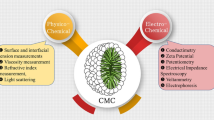Abstract
The critical micelle concentration (CMC) values of a 49-surfactant dataset, among them 30 derived from α-hydroxy acids or from gluconolactone synthesized and characterized in our laboratory, were subjected to Quantitative Structure Property Relationship (QSPR) studies. In this study, a principal component analysis (PCA) was used to compare the behavior of the synthesized surfactants to commercial ones that are used as detergents. The PCA shows the importance of the molecular structure of a surfactant in determining its activity (application field). We found that gluconolactone derivatives exhibited the same activity as those observed for glucopyranoside derivatives. A partial least squares regression was used to build a model that describes the CMC of diverse surfactants as a function of molecular descriptors.
Similar content being viewed by others
References
Rosen M.J., The Relationship of Structure to Properties in Surfactants IV—Effectiveness in Surface or Interfacial Tension Reduction, Colloid Interface Sci. 56:320 (1976).
Ravey, J.C., A. Gherbi, and M. Stebe, Comparative Study of Fluorinated and Hydrogenated Nonionic Surfactants. I—Surface Activity Properties and Critical Concentration, Prog. Colloid Polym. Sci. 76:234 (1988).
Becher, P., Hydrophile-Lipophile Balance: History and Recent Development, J. Dispersion Sci. Technol. 5:81 (1984).
Stanton, D.T., and P.C. Jurs, Development and Use of Charged Partial Surface Area Structural Descriptors in Computer-Assisted Quantitative Structure-Property Relationship Studies, Anal. Chem. 62:2323 (1990).
Stanton, D.T., and P.C. Jurs Computer-Assisted Study of the Relationship Between Molecular Structure and Surface Tension of Organic Compounds, J. Chem. Inf. Comput. Sci. 32:109 (1992).
Nelson, T.M., and P.C. Jurs, Prediction of Aqueous Solubility of Organic compounds, J. Chem. Inf. Comput. Sci. 34:601 (1994).
Katrizky, A.R., V.S. Lobanov, and M. Karelson, QSPR, The Correlation and Quantitative Prediction of Chemical and Physical Properties from Structure, Chem. Soc. Rev. 24:279 (1995).
Huibers, P.D.T., V.S. Lobanov, A.R. Katritzky, D.O. Shah, and M. Karelson, Prediction of Critical Micelle Concentration Using a Quantitative Structure-Property Relationship Approach. 1—Nonionic Surfactants, Langmuir 12:1462 (1996).
Anoune, N., M. Nouiri, C. Arnaud, S. Petit, and P. Lanten, synthesis and Characterization of New Cationic Surfactants Derived from Lactic Acid, J. Surfact. Deterg. 3:381 (2000).
Petit, S., N-(Dialkyamino) alkyl alpha carboxamides, compositions les contenant, procédés de préparation et utilisations, French patent 2 778 405-A1 (1999).
Petit, S., 5,6-Alkylidènes gluconolactones-1 (4) et dérivés, procédés de préparation et utilisations, French patent 97,04471 (1997).
Campbell, P., R. Srinivasan, T. Knoell, D. Phipps, K. Ishida, J. Safarik, T. Cormack, and H. Ridgway, Quantitative Structure-Activity Relationship (QSAR) Analysis of Surfactants Influencing Attachment of a Mycobacterium sp. to Cellulose Acetate and Aromatic Polyamide Reverse Osmosis Membranes, Biotechnol. Bioeng. 64:527 (1999).
Balaban, A.T., Highly Discriminating Distance-Based Topological Index, Chem. Phys. Lett. 89:399 (1982).
Kier, L.B., and L.H. Hall, Molecular Connectivity in Structure Analysis, Researched Studies Press, Letchworth, United Kingdom, 1986, p. 262.
Hall, L.H., and L.B. Kier, The Molecular Connectivity Chi Indices and Kappa Shape Indices in Structure-Property Modeling, in Reviews in Computational Chemistry, edited by K.B. Lipkowditz and D.B. Boyd, VCH Publishers, New York, 1991, p. 367.
Hall, L.H., and L.B. Kier, The Nature of Structure-Activity Relationships and Their Relation to Molecular Connectivity, Eur. J. Med. Chem. Chim. Therapeut. 4:307 (1997).
Wiener, H. Structural Determination of Paraffin Boiling Points, J. Am. Chem. Soc. 69:17 (1947).
Hansh, A Quantiative Approach to Biochemical Structure-Activity Relationships, Acc. Chem. Res. B2:232 (1969).
Dupeyrat M., Propriétés physico-chiniques spécifiques des agents de surface, edited by M. Dupeyrat, Technique et Documentation Lavoisier, Paris, 1983, p. 66.
Malinowski, E.R., Mathematical Formulation of Target Factor Analysis, in Factor Analysis in Chemistry, 2nd edn., Wiley-Interscience, New York, 1991, p. 32.
Author information
Authors and Affiliations
Corresponding author
About this article
Cite this article
Anoune, N., Nouiri, M., Berrah, Y. et al. Critical micelle concentrations of different classes of surfactants: A quantitative structure property relationship study. J Surfact Deterg 5, 45–53 (2002). https://doi.org/10.1007/s11743-002-0204-2
Received:
Accepted:
Issue Date:
DOI: https://doi.org/10.1007/s11743-002-0204-2




